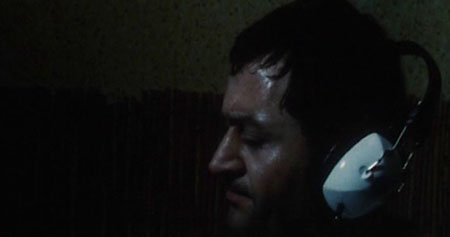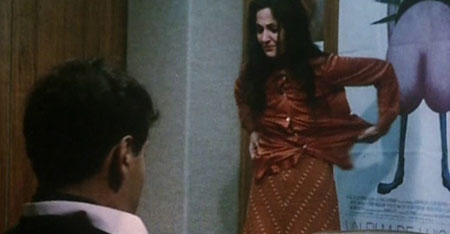SYNOPSIS:
A young actress throws herself into her work, unwittingly becoming a terrorist in the process.
REVIEW:
The film opens with a young actress sitting in a bathtub, listening to her director’s instructions through a radio/recording device. Hamdias, the mysterious director, has gone missing for the time being, but has recorded his direction for her to practice her acting at home. She listens to his directions on exactly how he wants her to scream, and how her screams need to reflect the torture that is being inflicted upon her.
She is playing a captured terrorist, and she is being tortured to give up information about those who have sent her. This is practice, a homemade acting class that allows her to hone her skills before she puts herself in front of the camera. This all seems like legitimate acting technique, training without having to waste precious film roll. Suddenly, the actress disrobes, revealing herself to be fully nude. She reaches across her lap desk to what appears to be a car battery, and she takes the cables and attaches one side to her nipple and the other to her vagina. She delivers a shock while recording her scream, getting closer and closer to the desired effect. This… seems less like a legitimate technique.
Gloria Mundi (aka Tortura) is, essentially, about method acting, and the lengths to which those who are dedicated to their craft will go to buy in completely. The actress tortures herself to make her reactions exactly perfect. She burns herself with cigarettes, electrocutes her body, and performs various other “enhanced interrogation techniques” on herself in pursuit of perfection. The director has instructed her to do these things, and has told her that when she has something to say to him, she should stare directly in front of herself, pretending to be speaking into a camera, and that will be just like if she was actually talking to him. This leads to many scenes of bizarrely uncomfortable staring, wherein we start to realize (as if the torture itself wasn’t enough of an indication) that our actress doesn’t quite have a handle on her sanity.
Shortly thereafter, the actress begins to build a very realistic looking plastic explosive device, because the director, through his recorded messages, has instructed her to do these things to “feel the danger.” When we’re introduced to the other principle characters in this drama, we begin to see an even more in-depth view of their paranoia, and their outside perspectives show us the very real possibility that Hamdias is creating actual terrorists out of his actors.
Their enemies are the CIA and the United Nations, who may or may not be listening to everything that’s going on. He is a Tyler Durden-like character, inspiring unquestioning loyalty and universal obedience, while also causing most of those under him to despise him. They are driven to violence, or at least possible violence, all at the behest of this unseen, almost mythical character. He seems to want to fight a very nationalistic fight, against those who are different: the Negroes, the Arabs, the Algerians. It is French nationalism to the extreme, at a time when this sort of thought process was even more common than it is now.
That’s where this film really hits home. The social import of these characters’ feelings is surprisingly valid today, with a lot of ultra nationalism coming from Europe, and lots of nationalistic rhetoric in American politics as well. We have Social Justice Warriors, Black Lives Matter, the seeming resurgence of the Ku Klux Klan, and various other Neo-Nazi and white nationalist groups coming to the forefront of politics and discourse. These feelings, and how the actors handle them, is as applicable today as it was when this film was made in 1976.
Interestingly enough, near the end of the film, when the half-completed film is brought by the actress to be screened for like minded libertines in France, the actress’ beliefs and convictions are mocked by those around her, who have a much more “detailed, intricate” view of such worldly things. They criticize her beliefs from a feminist and social libertarian perspective, showing that even among groups who care about things like this to the extent that they are willing to be violent radicals, disagreement and holier-than-thou perspectives ruin everything.
Even if you believe the same things, but not in the same way, your beliefs are looked down on, as are you. It’s an interesting parallel to groups today, where on sites like Tumblr, varying degrees of feminism are looked down upon by those with more extreme views. A woman who believes in gender equality is mocked by those who believe in female gender superiority, while someone who believes in gender superiority may be looked down upon by those who believe that all men should die. In the white nationalist sections of our society, those who hate African Americans, Latinos, and Muslims are despised by those who hate African Americans, Latinos, Muslims, and Jews. It’s a vicious, defeating cycle, and one that part of us must be grateful exists, lest these groups come together to form a more powerful and effective entity.
Gloria Mundi is a brilliant film, disturbing and visceral in its dissection of human nature and the desire to belong and succeed. It’s a discussion of how we can be convinced to do anything if we believe that it will put us in better shoes than where we started, and it shows exactly how far dedication can take us in the wrong direction. I don’t know what director Nikos Papatakis was trying to say, but I certainly know what he said: Sometimes, the puppet master really is pulling all the strings, and desperate and ambitious people who truly believe in the cause make the best puppets.
 Horror News | HNN Official Site | Horror Movies,Trailers, Reviews
Horror News | HNN Official Site | Horror Movies,Trailers, Reviews














